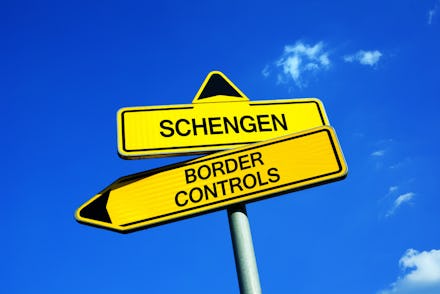Why you’ll get fewer passport stamps than you think traveling through Europe

When traveling internationally, you can (and should) expect to go through official border checkpoints anytime you cross into a new country; and, in most cases, have your passport stamped before you can proceed. That is, unless you’re in a European region known as the Schengen Area, where the border lines are a bit more blurred — at least when it comes to traveling across them.
What is the Schengen Area?
The Schengen Area was created in 1985 with the signing of the Schengen Agreement, a treaty that eliminated border restrictions between certain European countries. The treaty initially included only five countries; but today, there are 26 member countries, according to Schengen Visa Info. “The [European Union] Schengen Agreement allows for the free and borderless movement between over two dozen nations in Europe,” said Jeff Miller, one of the travelers behind Our Passion For Travel. Once inside the Schengen Area, he said, “travelers can move freely, without the need to pass border controls between these nations.”
Is the Schengen Area synonymous with the European Union?
There is crossover between the Schengen Area and the European Union (E.U.), but they’re not the same thing and don’t serve the same purpose. The former is all about the aforementioned elimination of border restrictions between member countries; while the latter is a political and economic union that consists of overarching judicial, legislative and financial institutions, among other things. “In terms of countries included [in the Schengen Area], it’s not all E.U. countries,” Miller said.
According to the European Travel Information and Authorization System (ETIAS), the E.U. countries of United Kingdom and Ireland are not part of the Schengen Area (and, of course, with Brexit, the U.K. will soon no longer be part of the E.U.). Four Schengen countries (Iceland, Norway, Switzerland and Liechtenstein) and three microstates (Monaco, Vatican City and San Marino) are members of the Schengen Area but not the E.U.
What do you need to enter the Schengen Area?
According to the U.S. State Department, travelers with U.S. passports can currently enter the Schengen Area without a visa (Schengen Visa Info lists the countries whose citizens do need visas) — but that will change in the coming years. As reported by Travel + Leisure, new guidelines going into effect in 2021 will require Americans traveling to the Schengen Area to first acquire an ETIAS visa. According to ETIAS, the online visa application process will be relatively simple and will require a valid U.S. passport as well as payment via credit or debit card; once approved, the visa will be valid for three years.
Until then, though, you can get into the Schengen Area with a U.S. passport that’s valid for at least 90 days after the date you intend to leave the zone; a “justifiable purpose of travel” (such as tourism); proof of sufficient funds for your stay; and passport validity and other requirements for each of the countries you plan to enter. For the latter, you can find those requirements by searching the State Department website. While you won’t need your passport to move between countries in the Schengen Area, “international visitors should keep their passport with them when visiting any overseas nation,” Miller said. “It is feasible to move freely between Schengen countries without, but you’ll still need it to get in and out of the Schengen zone.” Your stamped passport will also provide proof that you entered the zone legally, in case you run into any issues or questioning.
How long can you stay in the Schengen Area?
The free movement between Schengen countries doesn’t include a free pass to stay as long as you want. With a U.S passport, you can stay in the area for up to 90 days for tourism or business within any 180-day period. “For longer-term travelers, this means planning your travel efficiently to ensure you do not overstay your welcome in the Schengen zone,” Miller said. “For example, you may visit the Schengen zone in April and stay for the entire month, [then] return home and visit for July and August. This would exhaust the validity of a stay. In October, when the April visit drops off, this would free up another month that could be traveled — it’s a rolling six-month period.” Miller recommended keeping a record of your hotel bookings and other evidence of your time outside of the zone that you can provide to officials if necessary.
If you want to stay longer than 90 days within a 180-day period, you’ll need to apply for a visa; which you can do through the embassy of the country where you plan to spend the most time, according to the State Department.
As with any international travel, the key to having as smooth an experience as possible in the Schengen Area is preparation. Do your research on the countries you’re visiting, the documentation you’ll need, and your tentative itinerary; and be prepared to present all of the necessary information when asked.